How Translation and Transcreation are Different?

What’s Translation?
Well, if you ask anyone this question, they can easily answer as below.
Translation is the process of conveying the meaning of content from one language, called the source language., to another language, called the target language. This process considers the grammar, syntax, and terminology rules of both the source and the target language.
The mission of a translator is to faithfully convey the message in the source language to sound like it was written in the target language.
Translation requires the linguist to be aware of the target and source language’s lexical and syntax and also understand the subject matter of the text, and of course the culture.
Translation comes in different types, technical, legal, medical, multimedia, and literary translation. However, it is recommended that each translator is specialized in one or two types or fields of translation.
When Translation is needed?
Translation is essential when spreading new information across the world, communicating with other cultures, and doing business between two parties who speak different languages. It is possible to translate all types of written content, whatever the topic discussed and wherever it is published.
What’s Transcreation?
While translation focuses on rendering the meaning of a document, Transcreation on the other side focuses on recreating the effect of the message.
Let me elaborate more!
From a linguistic point of view, transcreation is not one word. it’s a combination of two words; translation and creation.
Sometimes people call it “Creative Translation”. The transcreation process in its simplest definition combines copywriting and translation.
It is when content is being adapted from one language to another while making sure the tone, intention, and emotions behind the content are delivered.
This can be achieved by adapting the message to the target market’s cultural background.
A transcreation professional or specialist is not only a linguist. He/she is a linguist with copywriting and creative writing skills.
And on top of that, the knowledge and cultural understanding of the target language audience.
This way, your target audience can resonate with your marketing text, advertisement, or slogans.
Transcreation is a matter of conveying emotions!
When Transcreation is Essential?
In addition to the above-mentioned areas, transcreation might also be essential in the following areas:
Slogans and taglines
Websites
Marketing content
Digital apps
Product names
So, How Translation is different from Transcreation?
A transcreator is more of a copywriter, while the translator is an information carrier
The main task of a transcreator is to keep the brand’s message and emotionally engage people with this message and motivate them to take the desired action.
This happens while preserving any original text’s humor, concepts, or idioms.
On the other hand, the translator’s task is to render the original message faithfully into the target language. This doesn’t mean it’s a word-for-word process, it’s keeping the same meaning in two different languages.
A Transcreator works according to a brief, while a translator sticks to a glossary
If a transcreator is more likely a copywriter, you will need to provide a brief.
It is a document that works as a guide for your transcreation specialist, to help them produce targeted material in the best way that serves your marketing needs.
It also provides information about the targeted audience, their culture, behaviors, and so on.
A translator doesn’t create content, so a brief is not needed. However, with some documents, you might need to provide some guidelines, the best glossaries, and your recommended dictionaries.
Time and cost are different between translation and transcreation.
Transcreation requires more language flexibility than translation.
A transcreator will spend hours doing market research and studying the company’s background, not to mention the number of rounds taken for drafting a good copy.
Simply, It takes time to create a copy that sells and this amount of time and effort needs to be compensated fairly.
Translation is a more direct process than Transcreation, which means less time, and less effort, which results in lower cost.
Frequently Asked Questions about “How Translation and Transcreation are Different?”
Conclusion:
People outside the translation industry believe that words are treated the same, and the translator is the man for all the tasks. This thought leads to making wrong decisions.
Next time you wish to carry across your message, consider translation. If you want your message to trigger thoughts, evoke emotions, or encourage the desired action; consider Transcreation.
